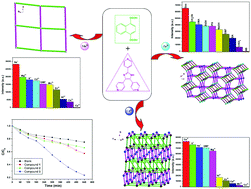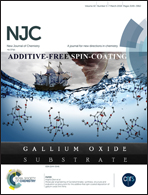Selective fluorescent sensing and photocatalytic properties of three MOFs based on naphthalene-1,4-dicarboxylic acid and 2,4,5-tri(4-pyridyl)-imidazole†
Abstract
The solvothermal reactions of MII (M = Mn, Zn, Cd) ions with naphthalene-1,4-dicarboxylic acid (H2L) and 2,4,5-tri(4-pyridyl)-imidazole (Htpim) gave rise to three MOFs, [Mn(L)0.5(L)0.5(Htpim)2]n (1), [Zn4(L)4(Htpim)2]n (2) and [Cd4(L)4(Htpim)2(DMF)2]n (3). Single-crystal X-ray diffraction analyses indicate that compounds 1–3 display diverse topologies. 1 possesses a 2D 44 network constructed by linking Mn centers, compound 2 exhibits a 3D (3,4,6)-connected {4·62}2{42·64}2{42·68·82·103} net interlinked by [Zn2L4] units, while compound 3 presents a 3D (3,7)-connected {42·5}{46·55·68·72} framework assembled by dinuclear Cd nodes. 1 and 3 display high sensitivity in the detection of nitrobenzene (NB) as fluorescent sensors and Ca2+ or Co2+ ions as luminescent probes. Moreover, 3 exhibits a relatively good photocatalytic activity towards the degradation of rhodamine B (RhB) in aqueous solution under UV irradiation.



 Please wait while we load your content...
Please wait while we load your content...